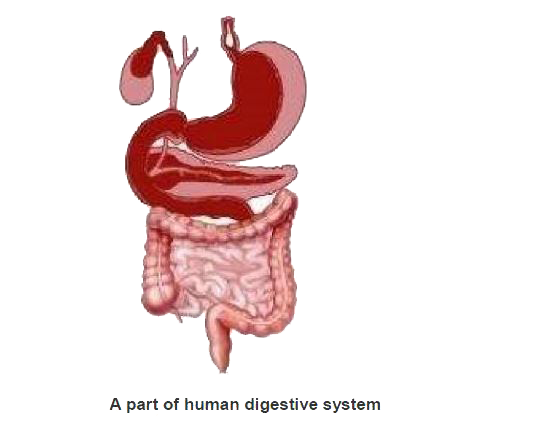What is meant by digestion? Name the various organs of the human digestive system. Also name the associated glands. Draw a labelled diagram of the human digestive system.
Step-by-Step Solution
Step 1: Understanding Digestion
- Digestion is the process by which complex food substances (like carbohydrates, proteins, and fats) are broken down into simpler forms that can be absorbed by the body. This process involves both mechanical (physical) and biochemical (chemical) methods.
Step 2: Identifying the Organs of the Human Digestive System
- The human digestive system consists of the following organs:
1. Mouth: The entry point for food where digestion begins.
2. Buccal Cavity: The space inside the mouth where food is chewed and mixed with saliva.
3. Esophagus: Also known as the food pipe, it transports food from the mouth to the stomach.
4. Stomach: A muscular organ where food is mixed with digestive juices and further broken down.
5. Small Intestine: The part of the digestive system where most digestion and absorption of nutrients occurs.
6. Large Intestine: Absorbs water and forms waste products (feces).
7. Rectum: The final section of the large intestine, where feces are stored before being expelled.
8. Anus: The opening at the end of the digestive tract through which waste is expelled.
Step 3: Identifying the Associated Glands
- The human digestive system is also supported by several glands:
1. Liver: Produces bile, which helps in the digestion of fats.
2. Pancreas: Produces digestive enzymes that help in breaking down carbohydrates, proteins, and fats.
Step 4: Drawing a Labeled Diagram
- To illustrate the human digestive system, draw a diagram that includes all the organs mentioned above, labeling each part clearly. The diagram should show the mouth, buccal cavity, esophagus, stomach, small intestine, large intestine, rectum, anus, liver, and pancreas.
- Digestion is the process by which complex food substances (like carbohydrates, proteins, and fats) are broken down into simpler forms that can be absorbed by the body. This process involves both mechanical (physical) and biochemical (chemical) methods.
- The human digestive system consists of the following organs:
1. Mouth: The entry point for food where digestion begins.
2. Buccal Cavity: The space inside the mouth where food is chewed and mixed with saliva.
3. Esophagus: Also known as the food pipe, it transports food from the mouth to the stomach.
4. Stomach: A muscular organ where food is mixed with digestive juices and further broken down.
5. Small Intestine: The part of the digestive system where most digestion and absorption of nutrients occurs.
6. Large Intestine: Absorbs water and forms waste products (feces).
7. Rectum: The final section of the large intestine, where feces are stored before being expelled.
8. Anus: The opening at the end of the digestive tract through which waste is expelled.
- The human digestive system is also supported by several glands:
1. Liver: Produces bile, which helps in the digestion of fats.
2. Pancreas: Produces digestive enzymes that help in breaking down carbohydrates, proteins, and fats.
- To illustrate the human digestive system, draw a diagram that includes all the organs mentioned above, labeling each part clearly. The diagram should show the mouth, buccal cavity, esophagus, stomach, small intestine, large intestine, rectum, anus, liver, and pancreas.
Topper's Solved these Questions
Similar Questions
Knowledge Check
Human digestive system consists of
AAlimentary canalBAssociated /digestive glandsCEndocrine glandsDBoth A and BThe largest gland in human digestive system is :
ALiverBSalivary glandCPancreasDGastric glandHuman digestive system does not hydrolyse
AstarchBcelluloseCglycogenDmaltose
(a) Name the main organs of the human digestive system. Also name the associated glands
(b) How do carbohydrates, fats and proteins get digested in human beings ?
View SolutionDifferent organs of the digestive system.
View SolutionDraw a neat diagram of digestive system of frog.
View SolutionLabel the following figure of the digestive system.

View SolutionIn human digestive system, bile is secreted by:
View Solution
